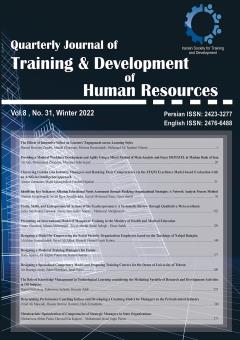Clustering Iranian Gas Industry Managers and Ranking Their Competencies via the EFQM Excellence Model-based Evaluation with an Artificial Intelligence Approach
Subject Areas :
Ali reza Zamanian
1
,
Majid Jahangirfard
2
*
![]() ,
Farshad Hajalian
3
,
Farshad Hajalian
3
1 - Islamic Azad University of Firoozkooh, Iran
2 - Assistant Professor, Department of Public Administration (Human Resources Management), Islamic Azad University of Firoozkooh, Iran
3 - Assistant Professor, Department of Public Administration (Human Resources Management), Islamic Azad University of Firoozkooh, Iran
Keywords: Managers’ clustering, artificial intelligence, big data, the European Foundation for Quality Management (EFQM) excellence model, Fisher discriminant ratio (FDR).,
Abstract :
This study attempted to lay the ground for linking human resources data based on the results of the organizational excellence model for about 51 parent and subsidiary companies of the National Iranian Gas Company using artificial intelligence (AI) and machine learning methods. The goal was to present a model for clustering chief organizational managers based on the companies’ evaluation using the European Foundation for Quality Management (EFQM)-based excellence model. The unique characteristic of this method is that it is formed based on the actual performance and output of successful organizations, headed by successful managers and leaders. Accordingly, a performance-based excellence model can be achieved in the future. The outcomes of model evaluation for 2017, 2018, and 2019 for 51 companies affiliated with the National Iranian Gas Company were first clustered. Clustering was performed for 3776 pieces of data via AI-based methods, and coding was done in Python. This applied study aimed to design and develop a novel method for discovering the experts and scientifically classifying the organization’s human resources based on credible data. It also aimed to integrate novel scientific domains of AI, including clustering, to pave the ground for human resources research. In the applied dimension, the results were used in organizational planning and decision-making to generate a tool whereby the future managerial performance of the organization and staff can be predicted based on appropriate human resources data. Finally, a ranking is presented based on the competency gap by using Fisher discriminant ratio (FDR).
1) Eubanks, B. (2019). Artificial Intelligence for HR. Great Britain and the United States: Kogan Page Limited.
2) Schwab, K. (1395). The Fourth Industrial Revolution. (M. Sha'ani, Trans.) Tehran: The Commerce Printing & Publishing Company.
3) Ulrich, D., Kryscynski, D., Brockbank, W., & Urich, M. (2017). Victory Through Organization. New York: Printed in the United States of America, McGraw-Hill.
4) Gopal, K. K. (2002). Measuring Business Excellence. London & New York: Routledge. Retrieved June 8, 2015
5) Sharma, A. K. (2007). Evolution of “universal business excellence model” incorporating Vedic philosophy. Measuring Business Excellence, 11(3), 4-20.
6) Calvo-Mora, A. D.-C. (2017). Assessment and improvement of organisational social impact through the EFQM Excellence Model. Total Quality Management & Business Excellence, 1-20.
7) Saeidloo, R. N. (2016). Influential Factors in Human Resource Excellence and Employees’ Satisfaction in Manufacturing Companies’ of Small and Medium Industries in Industrial Park of Tabriz city. International Journal of Humanities and Cultural Studies (IJHCS), 1(1), 1931-1941.
8) Rowshan, A., Forouharfar, A., & Fazel, A. (2015). The Study of the Relationship in the Dimensions of Human Resource Competency Model (HRCM) with Human Resource Excellence Model (HREM) in Iran's South Pars Economic Zone's Power Plants.
9) Hooley, T., Marriott, J., & Pearce, E. (2013). HR strategies for researchers: a review of the HR Excellence in Research Award implementation activities across Europe.
10) Magnaghi, E. (2017). Using the EFQM excellence model for integrated reporting: a qualitative exploration and evaluation. International Journal of Technology Management.
11) Najafzadeh, Y. (1393). Evaluation of Healthy Sports and Recreation Center of Aras Free Zone Based on Quality Excellence Model (EFQM). Tabriz: Aras International Campus, University of Tabriz.
12) Asadi, M. (2013). Organizational excellence model EFQM. Tarahan Houman.
13) Safari. H., S. M. (1395). Causal modeling of relationships between the criteria of the EFQM organizational excellence model in the Ta'avon Tose'e Bank. Industrial Management, 8(3), 423-446.
14) Adresi, A. & Tereski, M. (2013). EFQM Model 2013. Tehran, Iran,: Nahrenovin.
15) Dicheva., Christo Dichev and Darina. (2017). Towards Data science Literacy. Journal of computer science, 2151-2160.
16) Chuprina Svetlana, Alexandrov Vassil, Alexandrov Nia,. (2016). Procedia Computer Science, 80, pp. 1780-1790.
17) Dahganpour, M. (1398). Model for identifying and predicting job competencies of data scientists based on data mining. University of Tehran.
18) Andrea De Mauro, Marco Greco, Michele Grimaldi, Paavo Ritala. (2017). Human resources for Big Data professions: A systematic classification of job roles and required skill sets. Information Processing and Management, 1-11.
19) Fayyad, U., Piatetsky-Shapiro, G. & Smyth, P. (1996). From Data Mining to Knowledge Discovery in Databases. AI Magazine, 17(3),37.
20) Shahrabi, J. & Shakurniaz, V. (1390). Data Mining. Tehran, Iran: Jahad Amirkabir University.
21) Corporation, T. C. (1999). Introduction to data mining and knowledge discovery (Thired ed.). By Two Crows Corporation.
22) Song, J.-D., & Kim, J.-C. (2001). Is five too many? Simulation analysis of profitability and cost structure in the Korean mobile telephone industry. Telecommunications Policy, 25(1), 101-123.
23) Carlo, V. (2009). Business intelligence: data mining and optimization for decision making. John Wiley and Sons.
24) Huang, Z. (1998). Extensions to the k-means algorithm for clustering large data sets with categorical values. Data mining and knowledge discovery, 2(3), 283-304.
25) Jain, A.K. & Dubes, R.C. (1988). Algorithms for clustering data. New Jersey, USA.: Prentice-Hall, Inc.
26) Khoshouei, M., Oreyzi, H., & Jahanbazi, A. (2018). Validation of Managers’ Promotional Assessment Center in Isfahan Gas Company. Knowledge & Research in Applied Psychology, 19(3), 34-49.

